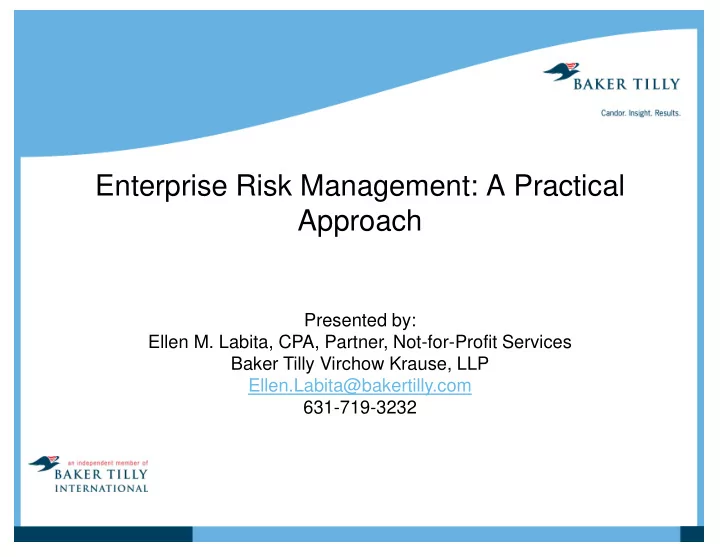

Enterprise Risk Management: A Practical Approach Presented by: Ellen M. Labita, CPA, Partner, Not-for-Profit Services Baker Tilly Virchow Krause, LLP Ellen.Labita@bakertilly.com 631-719-3232
Agenda • Overview of Enterprise Risk Management • ERM Process • Risk Assessment • Infrastructure / Ongoing Process 2
Risk management failures in history 1637: The tulip bulb craze 1720: The South Sea bubble 1989: The S&L crisis 1995: The Barings Bank derivatives scandal 2001: Enron 2002: WorldCom 2008: Housing collapse 2010: Gulf oil spill 2012: JP Morgan, Knight Capital 3
Risk is the possibility of an event occurring that will impact the achievement of an organization’s mission and objectives. RISK AND ITS IMPORTANCE WHY IS THERE AN INCREASED EMPHASIS ON RISK? 4
What is ERM? COSO definition – A process, effected by an entity’s board of directors, management and other personnel, applied in strategy setting and across the enterprise, designed to identify potential events that may affect the entity, and manage risk to be within its risk appetite, to provide reasonable assurance regarding the achievement of entity objectives . 5
COSO model Source: COSO, Enterprise Risk Management – An Integrated Framework 6
Why implement ERM: The Value Proposition • Broaden view of risk to address how it affects strategic plan and sustainability • Optimize the cost of risk management • Improve business performance • Improve process efficiency • Enhance governance 7
Tips for Implementing ERM Remember Keep it that risk is Get started simple and constantly doable changing 8
Keys to Success • Support of and from the top • Use incremental steps • Focus on key risks • Leverage existing resources • Build on existing risk management activities • Embed ERM into the business culture • Ongoing updates 9
Steps for ERM • Determine ERM leadership and working group • Define risk appetite • Conduct enterprise-wide risk assessment • Implement plan for high priority risks • Inventory/advance risk management infrastructure and reporting • Continuous update 10
Conducting Risk Assessment • Identify risks • Prioritize risks 11
Types of Risk Fraud Operations Finance Compliance Technology Strategy Reputation 12
Identify Risks • Brainstorm potential risks at a strategic entity-wide level • Alternatively, use an outside, objective party to interview key Board Members and Management and draft an initial set of priorities 13
Prioritize Risks • Prioritize risks based on significance (i.e., potential impact) and likelihood (i.e., chance of occurrence) • Use a risk map as a roadmap for discussions and oversight • Risks with the biggest potential impact and highest likelihood of occurrence are the top priority 14
Risk Mapping High Impact / High Impact / Moderate Likelihood High Likelihood Potential Impact Moderate Impact / Moderate Impact / Moderate Likelihood High Likelihood Likelihood of Occurrence 15
Sample Risk Map High Impact / Moderate Likelihood High Impact / High Likelihood Data Security and Privacy Funding Cuts/ Legal and Budgeting Regulatory Environment t c Media /Social Media a Business p Continuity Planning Information m and Disaster Retention and I Recovery Institutional l Program Safety a Knowledge i t n e t o P Governance Employee Conduct Effectiveness Growth Accounting Systems / Financial Management Reporting Succession Moderate Impact / High Likelihood Moderate Impact / Moderate Likelihood Likelihood of Occurrence Strategy Operations Compliance Reputation Technology 16
Implement for High Priority Risks • Clarify who is responsible for developing, implementing, and managing risk management plans • Who “owns” each risk and is responsible for developing plans? • The CEO/ED has ultimate responsibility for risk management in an organization • Develop responses/plans to manage and mitigate risk, and monitor results • This should include determining what risk management activities are already in place and weighing cost/benefit of risk reduction proposals 17
Risk Response • Avoid the risk • Seek an opportunity and exploit the risk • Remove the source of risk • Change the likelihood • Change the consequences • Share the risk with another party • Retain the risk 18
Key Questions Was the risk assessment process comprehensive? Are conclusions related to strategic risk appropriate? Are problems and solutions presented and discussed within a comprehensive context of competing priorities and resources? Are solutions transparently vetted in terms of alternative approaches? Are solutions discussed and decided based on risk/return characteristics? Do solutions address enterprise-wide risks? Are resources being allocated to key strategic risks and strategies to protect the organization and help achieve goals? 19
Risk Management Infrastructure and Reporting • Assess risk management capabilities • Develop/enhance infrastructure to reach the desired state of ERM • Develop reporting plan/requirements 20
Ongoing Process ERM is a journey, not a destination! 21
Recommend
More recommend